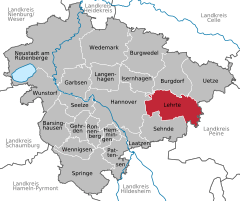Lehrte
| Lehrte | ||
|---|---|---|
| ||
 Lehrte | ||
Location of Lehrte within Hanover district 
 | ||
| Coordinates: 52°22′N 09°58′E / 52.367°N 9.967°ECoordinates: 52°22′N 09°58′E / 52.367°N 9.967°E | ||
| Country | Germany | |
| State | Lower Saxony | |
| District | Hanover | |
| Government | ||
| • Mayor | Klaus Sidortschuk (SPD) | |
| Area | ||
| • Total | 127 km2 (49 sq mi) | |
| Population (2015-12-31)[1] | ||
| • Total | 43,639 | |
| • Density | 340/km2 (890/sq mi) | |
| Time zone | CET/CEST (UTC+1/+2) | |
| Postal codes | 31275 | |
| Dialling codes | 05132 | |
| Vehicle registration | H | |
| Website | www.lehrte.de | |
Lehrte is a town in the district of Hanover, in Lower Saxony, Germany. It is situated approximately 17 km east of Hanover. In the 19th century Lehrte was the most important railway junction in the former Kingdom of Hanover. Nowadays it is a picturesque town with a population of 43,000 and a modern infrastructure, combined with local culture and an interesting history.
History
The first documented history of the area was in 1147 and shows that, what is now known as Lehrte, was a relatively insignificant farming village. Up to the year 1352, when the church, now known as Nikolauskirche, was built; the local farming residents attended Sunday church services in the village of Steinwedel.
At this time, Lehrte lay in the historical region known as the Großen Freien which literally translates to the big free and lay far from major transit and traffic routes.
Economy
Lehrte lay fairly dormant until 1843, when work began on the Hanover–Brunswick railway, linking Lehrte with both towns. In the following year, work began on building lines to Celle (1845), Hildesheim (1846) and Berlin (1871).
When work on the railway line commenced, Lehrte had 755 inhabitants, 60 years later the population had increased approximately ten times. In 1898 the area of Lehrte was granted municipal rights and formally recognised as a town.
With the railway well and truly established, industry grew within Lehrte, including clay works, a mineral fertilizer works, a cement factory, canned goods and a sugar factory in 1883 which, until 2002, dominated the centre of the town. The cement factory was created in 1881 by Hermann Manske with other limited partners and was the second factory of the cement industry in the Hannover region.
In 1910 the cement factory was shut down. In 1911 a cattle market was established and Lehrte became the most important place for cattle trade and shipment in Northern Germany. In 1912, mining began on the potash reserves in the area. The Lehrter Bahnhof (Lehrte Station) in Berlin is named after Lehrte. It was opened in 1871 as the terminus of the line linking Berlin with Lehrte and Hannover, which later became Germany's most important east-west main line.
Since the 1920s, a large substation has existed in Ahlten, which in 1944 was the end of the experimental Lehrte-Misburg HVDC line.
Main sights
 Water tower "Lehrter Wasserturm"
Water tower "Lehrter Wasserturm" Festival in the "Lehrter Stadtpark" (2012)
Festival in the "Lehrter Stadtpark" (2012) Steam engine "Dampflok 052 Lehrte 245-h"
Steam engine "Dampflok 052 Lehrte 245-h"- The Rathaus (city hall)
People and residents of Lehrte
- Heinrich Bokemeyer (1679-1751), musicologist, choirmaster and composer, born in Immensen
- Kurt Hirschfeld (1902-1964), theatre director and dramaturge at the Schauspielhaus Zürich
- Werner Lampe (born 1950), German swimmer and Olympic medalist
- Ursula von der Leyen (born 1958), politician (CDU) and current Federal Minister of Defence
- Reinhard Mey (born 1942), singer-songwriter (folk)
- Gerhard Schröder (born 1944), politician (SPD) and former Chancellor of Germany
References
See also
| Wikimedia Commons has media related to Lehrte. |
